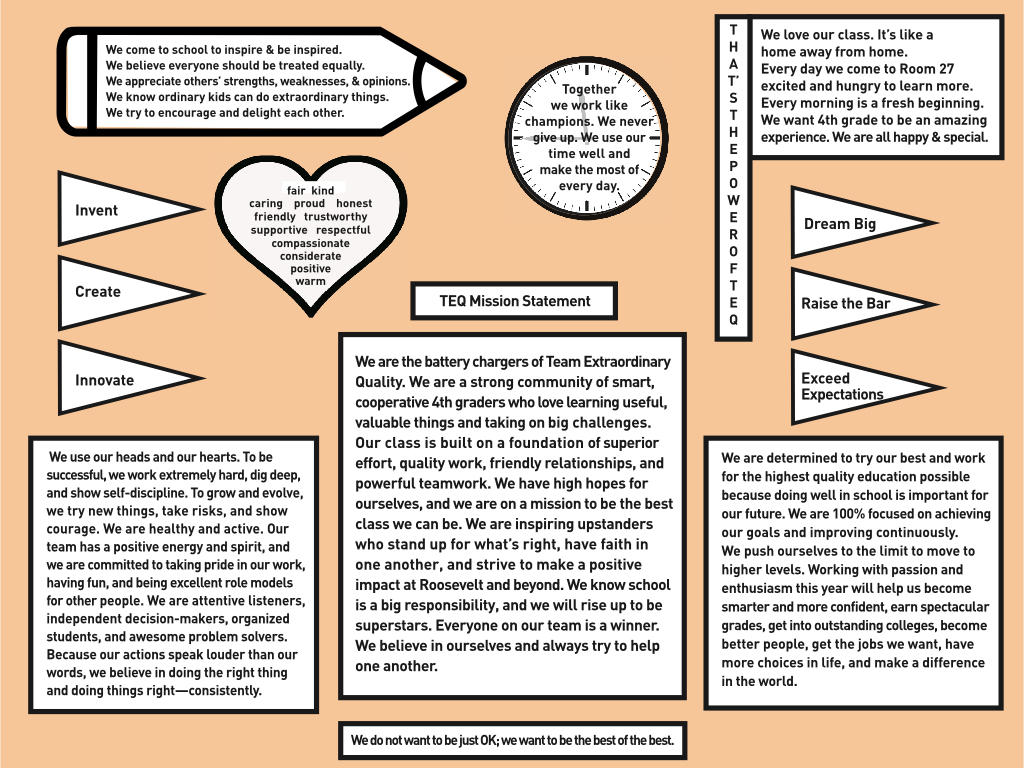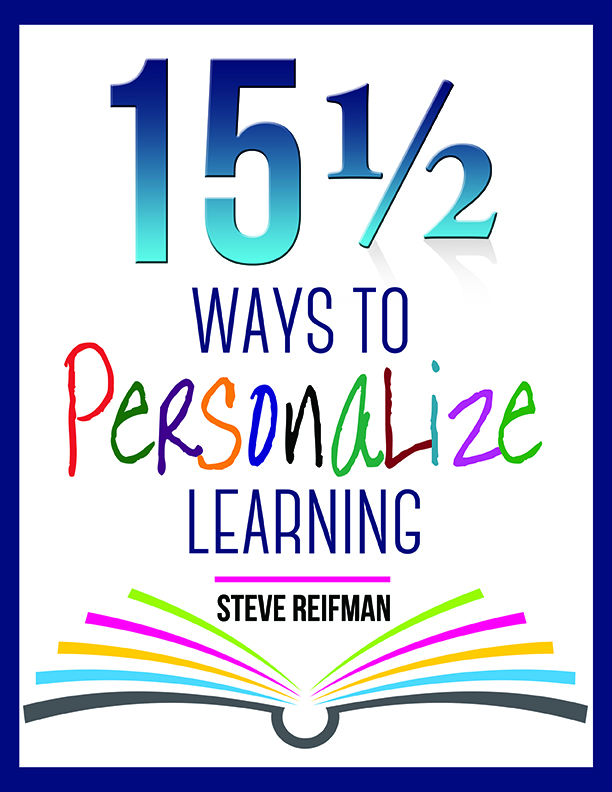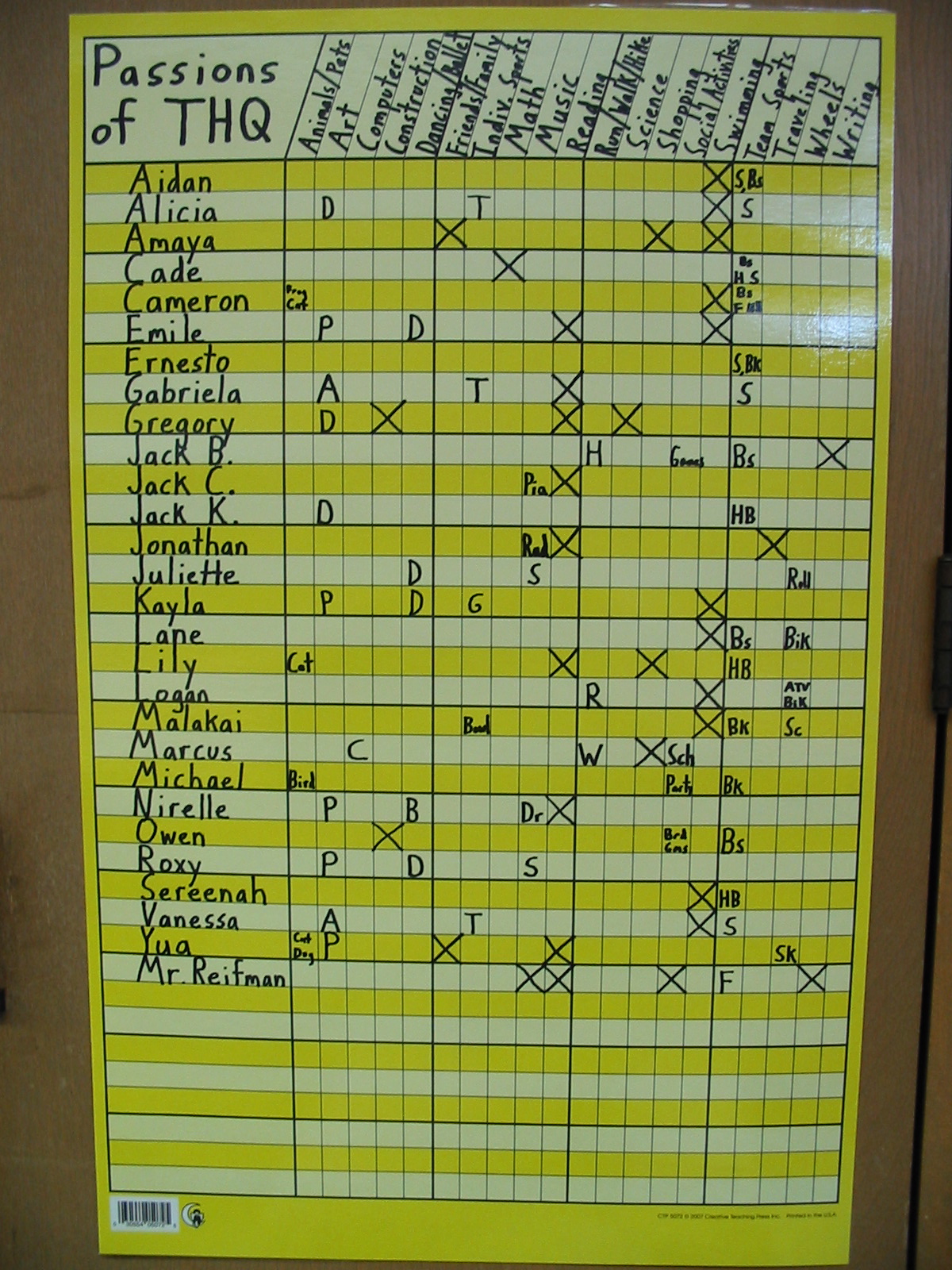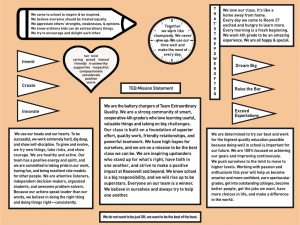
A New Look for This Year's Class Mission Statement
 My students and I just completed our class mission statement, and I decided to try a different format this year. Rather than present our ideas as a series of paragraphs, I designed the document to look like the front wall of a classroom. The text was fit inside a whiteboard, two bulletin boards, a clock, a flag, and other "classroom-themed" shapes. As much as possible, the meaning of the text matched the object in which it was placed. For example, the words "we use our time well and make the most of every day" were put in the clock. My hope is that this novel format will resonate with my students and give our ideas greater meaning.
My students and I just completed our class mission statement, and I decided to try a different format this year. Rather than present our ideas as a series of paragraphs, I designed the document to look like the front wall of a classroom. The text was fit inside a whiteboard, two bulletin boards, a clock, a flag, and other "classroom-themed" shapes. As much as possible, the meaning of the text matched the object in which it was placed. For example, the words "we use our time well and make the most of every day" were put in the clock. My hope is that this novel format will resonate with my students and give our ideas greater meaning.
Click here to see the full-sized version of our new class mission statement.
15 1/2 Ways to Personalize Learning
-
In this engaging book, National Board Certified elementary school teacher Steve Reifman presents a variety of proven, user-friendly teaching strategies, ideas, and activities that simplify the challenge of personalizing student learning and enable educators to meet children’s diverse needs confidently, effectively, and joyfully. -
We are living in a time when the Common Core standards and standardized testing are exerting an enormous influence on America’s schools. To help children meet these common expectations and score well on these common assessments, it may appear that teachers need to treat students the same way and use common methods. This couldn’t be further from the truth. Increased standardization will not lead to better academic performance. In fact, the opposite is true. Greater personalization will help children perform their best academically, develop their unique strengths and talents, and maximize their amazing potential.
This teaching resource is divided into four sections.
Part 1 describes five ways classroom educators can personalize the approach students take to their work.
Part 2 focuses on three ways to personalize academic instruction, including Steve’s favorite method of integrating technology in the classroom. Part 3 features three (and a half) ways to personalize student goals.
Part 4 contains four ways to personalize each child’s classroom experience.
There is also a link that provides access to a free PDF with over 25 printable pages that make it easy to incorporate the book’s ideas in the classroom.
Exciting Video Announcement
 In this video I announce the release of my new e-book on amazon, 15 1/2 Ways to Personalize Learning. In the book I present a variety of proven, user-friendly teaching strategies, ideas, and activities that simplify the challenge of personalizing student learning and enable educators to meet children’s diverse needs confidently, effectively, and joyfully.
In this video I announce the release of my new e-book on amazon, 15 1/2 Ways to Personalize Learning. In the book I present a variety of proven, user-friendly teaching strategies, ideas, and activities that simplify the challenge of personalizing student learning and enable educators to meet children’s diverse needs confidently, effectively, and joyfully.
This teaching resource is divided into four sections.
Part 1: Personalize the approach students take to their work
Part 2: Personalize academic instruction (This part includes my favorite method of integrating technology in the classroom.)
Part 3: Personalize student goals
Part 4: Personalize each child’s classroom experience
There is also a link in the book that provides access to a free PDF with over 25 printable pages that make it easy to incorporate the book’s ideas in the classroom.
Click here to see the book on amazon.com.
Click here to see the video.
NEW Video: Help Kids Pursue Their Passions

Watch this video now.
NEW Video: Give All Your Students Their Own "Thing"
 This video features a fun strategy designed teachers can use in the classroom to personalize everyone’s classroom experience and guarantee positive attention. When we give kids their own thing, it can be a nickname, a job, a gesture, a signal, or a private joke—anything that makes a child feel special and acknowledged as an individual. The goal is for every child to have or be known for something that is uniquely theirs.
This video features a fun strategy designed teachers can use in the classroom to personalize everyone’s classroom experience and guarantee positive attention. When we give kids their own thing, it can be a nickname, a job, a gesture, a signal, or a private joke—anything that makes a child feel special and acknowledged as an individual. The goal is for every child to have or be known for something that is uniquely theirs.
Watch this video now.
NEW Video: Help Children Improve Their Reading Skills
 This video features a wonderful resource we can use in the classroom to improve children's reading after we conclude our reading conferences with them. Conferring is a terrific way to personalize our strategy work for the benefit of each child. Follow-up is typically the primary challenge of conferring. For example, a student, during a reading conference, may do a fantastic job of making a thoughtful prediction before starting a new chapter, yet transferring that skill to her daily reading, where it matters most, may not come as easily.
This video features a wonderful resource we can use in the classroom to improve children's reading after we conclude our reading conferences with them. Conferring is a terrific way to personalize our strategy work for the benefit of each child. Follow-up is typically the primary challenge of conferring. For example, a student, during a reading conference, may do a fantastic job of making a thoughtful prediction before starting a new chapter, yet transferring that skill to her daily reading, where it matters most, may not come as easily.
To help facilitate stronger transfer, we can use simple tools called visual reminder cards. Each card is a small, index-card-size sheet that contains the name of a specific strategy, a corresponding image, and a brief definition or description of the strategy. At the end of a conference, I like to present students with a visual reminder card focused on the strategy we just practiced. The kids then take the card back to their seats and keep it on their desks as a quick, easy reference. Seeing the card in front of them as they read significantly increases the likelihood that students will use the strategy we discussed. In addition, when the kids are all displaying their cards in this manner, it allows me to circulate through the room and know instantly which strategies to reinforce.
Watch the video now.
2 NEW Short Instructional Videos for Young Mystery Writers
If your child is interested in writing a mystery adventure, you may also want to consider "The Ultimate Mystery Writing Guide for Kids" on amazon.com.
In both the course and the guide, I combine the knowledge and skills I have developed during my 22-year teaching career with numerous examples from my Chase Manning Mystery Series to teach children about crimes, crime solvers, suspects, motives, clues, witnesses, alibis, red herrings, and all the other elements that make mysteries so much fun to read and write.
New Short Video: What are the 5 Most Important Traits Needed for School Success?
Click here to watch the video.
The Awesomeness of Problem-Based Learning (Part 7)
When children work together on an academic activity, teachers, of course, want each group to complete the task successfully and produce quality work. The primary goals of cooperative learning, however, have less to do with the final products the kids create and more to do with the development of important habits of character that will serve students well throughout their lives. For example, when members of a group work together, we want the students to treat one another with kindness and respect, be open to the ideas of others, solve disagreements peaceably, maintain their focus without straying off task, and take pride in the final product the group produces. These are extremely valuable life skills.
Thrively helps take cooperative learning to an even higher level. Now, in addition to focusing on important habits of character, students can use the information from the strength assessment results to determine how each member is able to contribute most effectively to the team's efforts. My favorite example of this phenomenon happened when one student noticed that his write-up described him as a strong "big picture" thinker while his partner's mentioned a keen ability to pay attention to detail. In a really cool "aha" moment, the first child said, "Hey, when we start our project, I can try to think of the big ideas, and he can help with the details."
Children who display the habits of character that cooperative learning requires and possess the ability to analyze each group member's strengths to determine how everyone can contribute fully to the team will become our leaders of tomorrow. Bringing this mindset to cooperative learning will empower students to maximize both individual and team potential. Strength-based cooperative learning will also provide children with experiences that more closely resemble the type of work they will do as they progress through school and enter our 21st century economy.
The Awesomeness of Problem-Based Learning (Part 6)
After my students took this online strength profile, my original plan was to meet individually with each child to discuss the results and determine the different ways we could incorporate the identified strengths into our daily learning and try to develop them further. Our daily independent reading period is the only consistent time I have to confer with the kids, but I knew I needed to devote the next two weeks of conferring time to conducting one-on-one reading assessments.
Rather than wait, I decided to hold these conversations while the children were working on the Community Resource Project. Instead of meeting with each individual child, I met with each group. I thought this decision would allow me to go over the strength profiles in a manner that was more efficient and that wouldn’t take too much time away from each group’s work.
An unexpected benefit of this decision soon surfaced that was far more important than efficiency.
After first gaining each child’s consent to share the assessment results with their partner present, I read the write-ups aloud as all group members listened. I quickly realized that it’s one thing for children to hear their teacher describing their strengths. It’s quite another for children to hear their teacher describing their strengths while peers listened to the entire conversation.
Presenting the write-ups to a whole group, as opposed to individual children, changed the dynamic significantly and took what otherwise would have been a private moment and transformed the occasion into an event in which students felt as if they were in the spotlight, gaining attention for something that was 100% positive and gaining validation and respect for the skills and attributes they brought to the group. This was especially valuable for students who may have never before received this type of recognition. The self-esteem boost was incredible.
From now on, every time my students begin a group project with new partners, I plan to review the strength profiles in this way to get the team off to a great start.
Next time, I will share another significant benefit of using Thrively in the classroom: helping each group perform more effectively.







